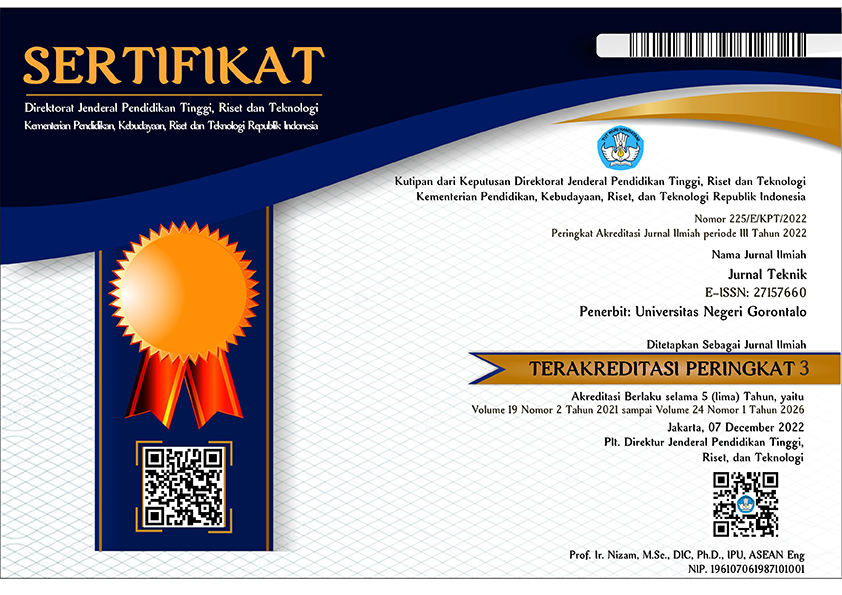Komparasi Performa Insulasi Termal Antara Dinding Batu Bata dan Batu Bata dengan Penambahan Insulasi Alang-Alang
Abstract
Buildings consume about 40% of the world's energy, beginning from the process of making the building itself to how the building could meet human thermal comfort needs. In the past, reeds were often used in traditional buildings, but unfortunately these days the practice is being abandoned. Several studies have shown that weeds can reduce building temperatures. However, these studies research has not examined how reeds are used as insulation material along with bricks so the purpose of this study is to compare the thermal insulation performance between plain brick and brick wall with the addition of reed insulation. The method used in this research is to use Ecotect simulation. Based on the results of simulations carried out it is known that model 1, namely the plain brick wall, has an outside-inside temperature difference of -1.32917 ° C. This means that the average temperature inside is hotter than the outside temperature by 1.32917 ° C. Meanwhile in model 2, the brick wall with the addition of reeds insulation has an outside-inside temperature difference of 0.445833 ° C. This means that the average temperature inside is cooler than the outside temperature by 0.445833 ° C. Therefore, it can be concluded that reeds could be used as thermal insulation material because it could store heat better than the material in Model 1, which is a plain brick wall.
Downloads
References
Almusaed, A. & Almssad, A. (2015). Building materials in eco-energy houses from Iraq and Iran. Case Studies in Construction Materials, 2, 42-54. Retrieved from https://www.sciencedirect.com/science/article/pii/S2214509515000029.
Alpára,T., Schlosser, M., Hajdu, I & Bejóa, L. (2012). Developing building materials from cement-bonded reed composite based on waste materials. International Scientific Conference On Sustainable Development & Ecological Footprint.
Asdrubali, F., D’Alessandro, F., & Schiavoni, F. (2015). A review of unconventional sustainable building insulation materials. Sustainable Materials and Technologies, 4, 17-34. Retrieved from https://www.sciencedirect.com/science/article/pii/S2214993715000068.
Asih, D. S. (2012). Pengaruh material pelapis pada fasade bangunan terhadap nilai ottv. Magister Thesis, Universitas Indonesia.
Hong, S. H., Gilbertson, J., Oreszczyn, T., Green, G. & Ridley, I. (2009). A field study of thermal comfort in low-income dwellings in England before and ater energy efficient refurbishment. Building and Environment, 44, 1228-1236.
Pratiwi, N., Hamzah, B., & Mulyadi, R. (2019). Alang-alang sebagai material insulasi termal. Smart: Seminar on Architecture Research and Technology, 2, 3-12. Retrieved from https://smartfad.ukdw.ac.id/index.php/smart/article/view/74.
Sterflinger, K., Ettenauer, J., & Pinar, G. (2013). Bio-susceptibility of materials and thermal insulation systems used for historical buildings. Energy Procedia, 40, 499-506. Retrieved from https://www.sciencedirect.com/science/article/pii/S1876610213016512
Sudirham. (2015). Sifat-sifat termal. Retrieved from www.darpublic.com.
Sugini, D. (2014). Kenyamanan termal ruang. Yogyakarta: Graha Ilmu.
Suwantara, K. & Dawayanti. (2012). Karakteristik termal pada Uma Lengge di Desa Mbawa Nusa Tenggara Barat. Denpasar: Balai Pengembangan Teknologi Perumahan Tradisional Denpasar, Puslitbang Permukiman Badan Litbang Kementerian Pekerjaan Umum.
Suwantara, K. & Rini, N. (2011). Kinerja termal rumah tradisional Uma Kbubu. Denpasar: Balai Pengembangan Teknologi Perumahan Tradisional Denpasar, Puslitbang Permukiman Badan Litbang Kementerian Pekerjaan Umum.
Copyright (c) 2020 Niniek Pratiwi, Baharuddin Hamzah, Rosady Mulyadi (Author)

This work is licensed under a Creative Commons Attribution-ShareAlike 4.0 International License.













